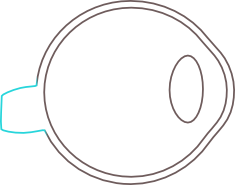All about Glaucoma

Glaucoma is caused by damage to the optic nerve that connects the eye to the brain. If left untreated it can cause significant loss of vision. The most common type of glaucoma is caused by a build up of the aqueous humour fluid in the front of the eye.
What causes glaucoma?
If the fluid in the front of the eye (the 'anterior chamber') is unable to drain properly, or the eye produces fluid too quickly, the intra-ocular pressure can build up. In the early stages, glaucoma tends to affect peripheral vision, so you may not notice it at first; studies have shown that people can lose up to 40% of their vision before they notice anything is wrong. This is one of the reasons why it's important to have your eyes examined regularly, so changes can be detected as soon as possible. Glaucoma is usually age-related, tends to run in families, and is more common in people of black-African or black-Caribbean origin.
What types of glaucoma are there?
The most common type is called 'chronic open-angle glaucoma' and it tends to develop quite slowly. 'Primary angle-closure glaucoma' is rarer and can develop slowly ('chronic') or rapidly ('acute'). 'Secondary glaucoma' occurs as a result of injury or following another eye condition such as 'uveitis'. Finally, 'developmental glaucoma' sometimes occurs in very young children due to an abnormality in the structure of the eye.
How is glaucoma treated?
Most people with glaucoma use specially prescribed eyedrops to control their condition, but more recently laser procedures have also been shown to be effective for many patients. If these treatments do not control the condition, surgery is sometimes necessary to help reduce the intra-ocular fluid pressure.
If is important to detect glaucoma as early as possible because any loss of vision cannot be reversed. The aim of treatment is to control the condition and reduce the risk of any vision loss progressing.